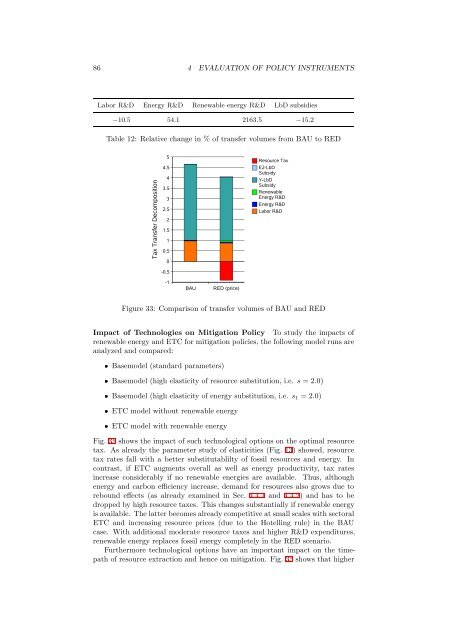Modeling Climate Policy Instruments in a Stackelberg Game with ...
Modeling Climate Policy Instruments in a Stackelberg Game with ...
Modeling Climate Policy Instruments in a Stackelberg Game with ...
Create successful ePaper yourself
Turn your PDF publications into a flip-book with our unique Google optimized e-Paper software.
86 4 EVALUATION OF POLICY INSTRUMENTS<br />
Labor R&D Energy R&D Renewable energy R&D LbD subsidies<br />
−10.5 54.1 2163.5 −15.2<br />
Table 12: Relative change <strong>in</strong> % of transfer volumes from BAU to RED<br />
Figure 33: Comparison of transfer volumes of BAU and RED<br />
Impact of Technologies on Mitigation <strong>Policy</strong> To study the impacts of<br />
renewable energy and ETC for mitigation policies, the follow<strong>in</strong>g model runs are<br />
analyzed and compared:<br />
Basemodel (standard parameters)<br />
Basemodel (high elasticity of resource substitution, i.e. s = 2.0)<br />
Basemodel (high elasticity of energy substitution, i.e. s 1 = 2.0)<br />
ETC model <strong>with</strong>out renewable energy<br />
ETC model <strong>with</strong> renewable energy<br />
Fig. 35 shows the impact of such technological options on the optimal resource<br />
tax. As already the parameter study of elasticities (Fig. 13) showed, resource<br />
tax rates fall <strong>with</strong> a better substitutablilty of fossil resources and energy. In<br />
contrast, if ETC augments overall as well as energy productivity, tax rates<br />
<strong>in</strong>crease considerably if no renewable energies are available. Thus, although<br />
energy and carbon efficiency <strong>in</strong>crease, demand for resources also grows due to<br />
rebound effects (as already exam<strong>in</strong>ed <strong>in</strong> Sec. 4.4.1 and 4.4.2) and has to be<br />
dropped by high resource taxes. This changes substantially if renewable energy<br />
is available. The latter becomes already competitive at small scales <strong>with</strong> sectoral<br />
ETC and <strong>in</strong>creas<strong>in</strong>g resource prices (due to the Hotell<strong>in</strong>g rule) <strong>in</strong> the BAU<br />
case. With additional moderate resource taxes and higher R&D expenditures,<br />
renewable energy replaces fossil energy completely <strong>in</strong> the RED scenario.<br />
Furthermore technological options have an important impact on the timepath<br />
of resource extraction and hence on mitigation. Fig. 35 shows that higher
















